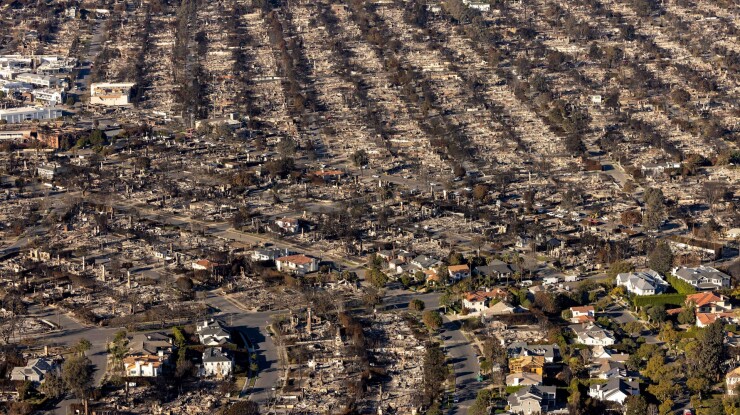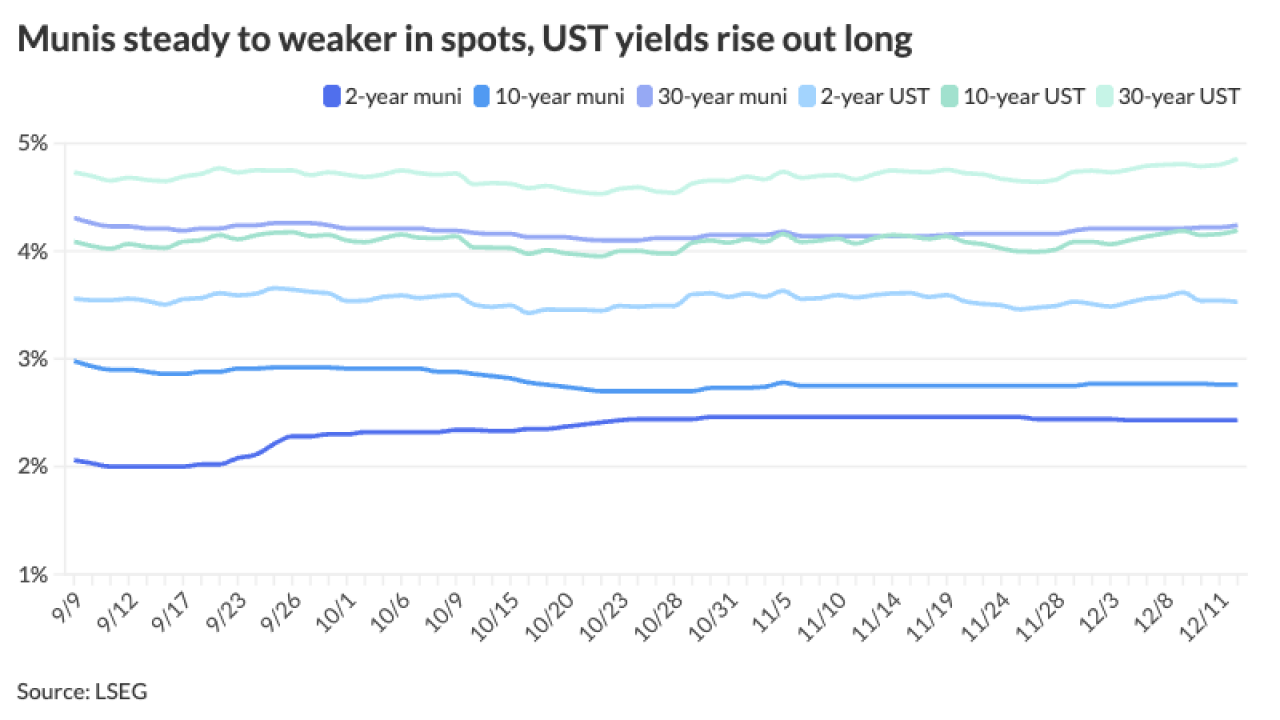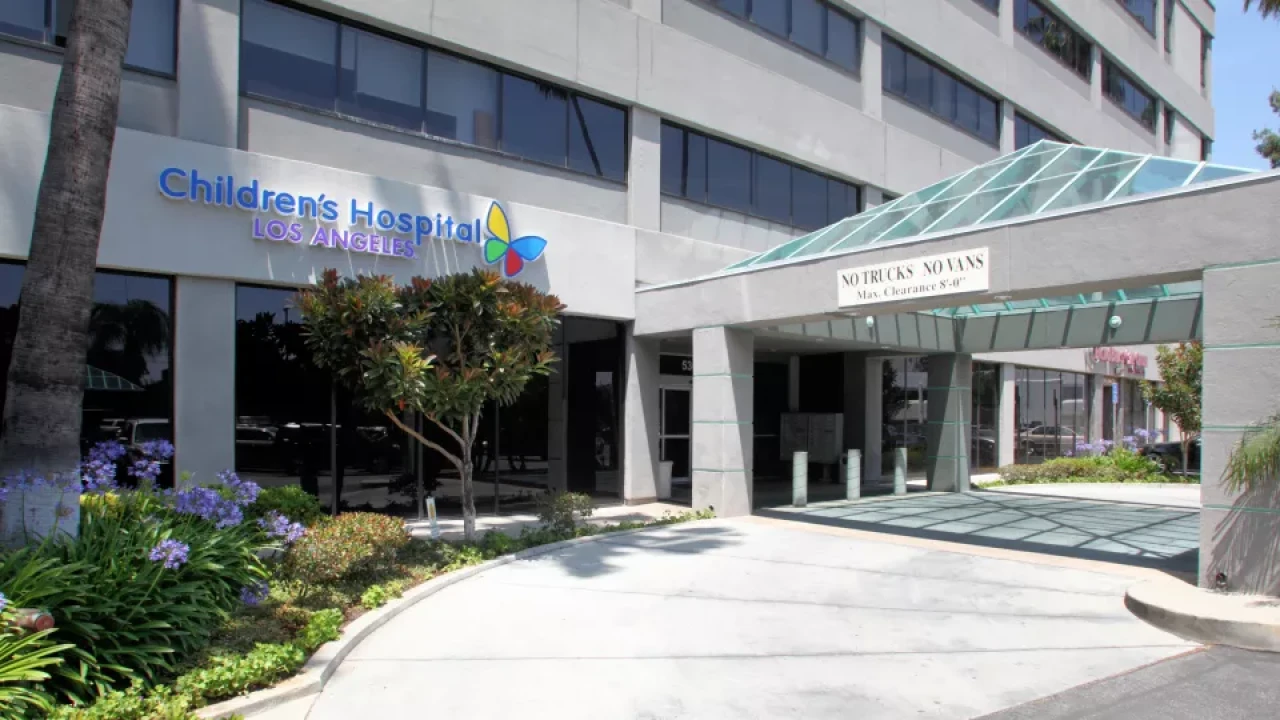
Public finance credits in Southern California are beginning to feel the heat from the massive wildfires that have destroyed parts of the city and county of Los Angeles.
The city's AA-rated general obligation bonds were placed on CreditWatch with negative implications by S&P Global Ratings late Wednesday.
Kroll Bond Rating Agency Thursday put bonds issued by the city and its Department of Water and Power on Watch Downgrade Thursday. S&P had already
The credit uncertainty comes amid a massive natural disaster that is still unfolding, making it harder to forecast its ultimate consequences.
The wildfires are shaping up to the be the
Heavily populated neighborhoods were devastated after wildfires quickly spiraled out of control after 80- to 100-mile Santa Ana winds struck a tinder-dry region Jan. 7.
Analysts say it's too soon to accurately gauge if there could be a wave of downgrades.
The two largest fires — Palisades and Eaton — are still burning and there is some uncertainty around assumptions that have protected ratings during previous natural disasters.
"Our whole answer is: it's too soon to know," said Karen Krop, a Fitch Rating senior director. "We just don't know yet."
The Palisades fire has wreaked havoc on a large swath of west side Los Angeles down to its beaches and stretched into the San Fernando Valley, while the Eaton fire and other east side fires caused destruction from Sunland down to Altadena.
As of Thursday, 24 lives had been lost, 12,300 structures had been destroyed and 40,660 acres had burned in the Los Angeles region, according to the California
AccuWeather predicted economic damages of $250-275 billion, as compared to inflation-adjusted damages of
The wildfires are "already likely to have caused up to a record $30 billion in insured losses, easily surpassing the $12.5 billion in losses caused by the
"While losses are estimated to be significant, we do expect federal, state, and insurance proceeds will support the rebuilding efforts and, despite recent spread widening, we anticipate a full recovery in credits with unlimited taxing power over time," JPMorgan analysts wrote.
"At the same time, we think the outcome in utility credits is more open-ended and difficult to predict," they wrote.
The "state has some flexibility in what it can do, though it has to deal with some uncertainty, because of the
Uncertainties
Among funding challenges when the city can start to rebuild are uncertainties about whether the Federal Emergency Management Agency would reimburse local governments for much of the cost, which
Members of the GOP majorities in Congress have gone on record saying they
The state's property insurance challenges may throw another monkey wrench into rebuilding plans.

And, though the California Department of Finance announced a small
California Gov. Gavin Newsom proposed the state provide $2.5 billion in additional funding for ongoing emergency response efforts and to jumpstart recovery efforts for Los Angeles. That was to be taken up in a special session this week, but has been postponed by lawmakers to Jan. 22.
"California is organizing a
Democrats in the state legislature have introduced a proposal to provide $50 million to fund legal efforts to challenge Trump administration changes that cut federal funds to California. Democratic State Sen. Scott Wiener, who is chairman of the budget committee, said Monday in a press briefing the disaster relief and Trump bills would be merged.
That announcement from Wiener brought an outcry from Republicans.
Republican Assembly Minority Leader James Gallagher criticized the move to combine the measures on a post on the social network X, saying it would force his party's members to vote against disaster relief, if they want to reject funding to avert
"We all want to help Los Angeles recover and be there for people who are suffering just like people were there in Paradise when we were recovering,"
Unknown toll
With the blazes still burning, officials are far from a definitive assessment of how many houses and other properties were lost in the fires.
"There is a lot of fire to put out before the implications are clear," Krop said.
"It's too soon to tell what amount of rebuilding will occur," said Karen Ribble, a Fitch senior director of public finance. "We don't know the degree of underinsured or not insured houses. The cost of insuring, and rebuilding, means there will be headwinds to a full recovery."
Despite the tragic sweep of the disaster, property tax impacts are apt to be mitigated by the sheer size of the impacted local governments.
Los Angeles County has almost 2.4 million property parcels, according
Los Angeles city has 795,000, including more than 618,000 single-family parcels. While not every parcel has a structure, and some have more than one, it still gives a sense of the broad shoulders of the region's tax base and economy.
Los Angeles Mayor Karen Bass issued
"This unprecedented natural disaster warrants an unprecedented response that will expedite the rebuilding of homes, businesses and communities," Bass said in a statement. "This order is the first step in clearing away red tape and bureaucracy to organize around urgency, common sense and compassion."
Though the Bass administration announced in December that the city
"All of our Los Angeles credits are double-A, other than Los Angeles County, which is triple-A," Ribble said. "Those ratings suggest a fair amount of flexibility to withstand shocks to a certain degree."
S&P, putting Los Angeles on CreditWatch this week, citied "our view of the city's weakening financial trends and the introduction of additional credit risk tied to the multiple wildfires that began on Jan. 7."
The KBRA Watch Downgrade applies to the LADWP's AA-rated power system revenue bonds, AA-plus-rated water system revenue bonds, AA-plus-rated Los Angeles general obligation bonds and AA-rated Municipal Improvement Corporation of the City of Los Angeles bonds.
"Given this rapidly evolving, highly complex and unprecedented natural catastrophe, KBRA believes it is premature to change any ratings until such time as we have sufficient visibility into the ramifications for affected issuers to make an informed credit assessment," KBRA analysts said in the report.
"While none of LADWP's infrastructure, equipment or processes have, to date, been implicated as a cause of or contributor to the wildfires, the Department faces potential inverse condemnation risk and related legal and financial exposure, regardless of negligence, if its Power System or Water System infrastructure is found to have contributed to wildfire-related property damage," KBRA wrote.
The city government itself, acting through LADWP, may have potential exposure to wildfire liability claims, KBRA wrote. "Additionally, in our view, the ongoing wildfires have the potential to strain the City's financial position by necessitating an increase in unbudgeted expenditures and reducing available liquidity."
Evaluating what he dubbed the "disaster-preparedness ecosystem" is key to analysis as extreme weather events become more common and more costly, said Mohammed Murad, head of municipal credit research at PT Asset Management, LLC.
"As a credit analyst, I tell myself you cannot predict the timing, frequency or severity of natural disasters, but we can consider the preparedness and credit strength and the resilience of issuers," Murad said.
"You have federal assistance through FEMA, and then the availability and affordability of private insurance to residents, as well as state support, whether in the form of a disaster fund like the California Wildfire Fund or if the state is serving as a backstop insurer of last report," he said. "And then finally you have state regulations around zoning and construction standards, which are seen as preparedness measures."
The history of munis has shown limited long-term credit impact from disasters, although in the short term, liquidity may be tested as a credit is forced to pay for upfront costs to address rebuilding, Murad said.
In a Jan. 9 report, S&P Global Ratings analysts opined that insurers can absorb losses amid escalating Los Angeles-area wildfires.
The losses, estimated at that point as up to $15 billion, have soared to close to $30 billion, Patricia Kwan, primary credit analyst on the report, said in an interview Wednesday.
The original estimates were in line with the estimated $16 billion for the Tubbs Fire in northern California in 2017 and the $14 billion estimated for the Camp Fire in 2018, S&P analysts wrote.
Though the losses are steep, Kwan said insurers are expected to absorb them. The uncertainties in California's property insurance ecosystem could be balanced by the state's efforts to reform the insurance landscape.
She noted that State Farm Mutual Automobile Insurance Co, Allstate Corp. and Hartford Financial Services Group Inc., have either "reduced exposure to or exited" the California homeowners insurance market over the past two years.
"For now, we believe the impact of the wildfires is manageable for global reinsurers, with no major impact on earnings," S&P analysts wrote. "This is because we estimate losses will stay within their natural catastrophe budgets for first-quarter 2025."
Miller Tabak Asset Management CEO Mike Pietronico encouraged investors to buy Los Angeles-related paper after spreads significantly widened this week.
"There will be an 'LA penalty' and there will be some widening on the state's debt," Pietronico posted on the social media network X. "Be Warren Buffet in times of crisis. Take advantage of those who panic. Spreads will widen – buy the dip."
Earlier disasters
Hurricane Ian, which
Following Katrina in September 2005, Moody's placed 51 credits in Louisiana and Mississippi on watch for downgrade, according to the JPMorgan report.
Following the rating agency's review, in December 2005, according to JPMorgan's report, 29 of the 51 credits were ultimately downgraded, due in large part to anticipated declines in tax base values and population/enrollment losses; the remaining 21 were confirmed and 1 rating was withdrawn.
"In terms of sector, by count, small local issuers constituted most of the downgraded credits, but in terms of debt outstanding, states (LA and MS) accounted for most of the downgraded debt," according to the JP Morgan report." In terms of security type, by count, general obligation credits constituted most of the downgrades."
In a report investment advisory firm Miller Tabak sent to clients Sunday, the firm said it does not expect payment defaults, but it does expect negative credit implications and various downgrades for Los Angeles-area municipalities.
"There has never been a payment default in U.S. public finance history due to a natural disaster," the firm said in the note.
Miller Tabak cited a July 2024 report from Moody's Ratings that said the "continued absence of rated defaults due to natural disasters" is an "interesting trend."
Although
The threat of litigation has already resulted in downgrades from S&P for the Los Angeles Department of Water and Power as the municipal utility delayed a water revenue bond that had been
The ratings for Utah's
The nation's largest municipal utility is also its operating agent and project manager.
When California Gov. Gavin Newsom released his preliminary fiscal 2024-25 budget last week, the state was heading into budget talks with a surplus, but the wildfires have compounded the air of uncertainty already created by vitriol Trump has lobbed at the state.
He'll update his budget proposal in May.
"At that point, there will be a better sense as to how many taxpayers will be able to defer – and hopefully more concrete information as to what the impact has been," Krop said.
State officials – both the Department of Finance and the Legislative Analyst's Office – have noted there are deficits in the "out years" beyond the current year budget, and Fitch analysts will be watching to see if they "bring the budget back into structural alignment," Krop said, adding the latter is an issue Fitch has noted in previous ratings reports.
The
In previous years when local governments were hit by reduced taxes from the loss of homes and the resultant reduction in assessed property values when homes were lost, lawmakers have provided funding to cities to make up the difference.
Santa Ana winds were expected to "gradually subside on Wednesday, though very dry conditions were expected to persist through Thursday. Calmer and more humid weather is anticipated by the weekend," according to CalFire.
The Palisades Fire, which has burned 23,713 acres, was 22% contained as of Thursday and the Eaton Fire, which has burned 14,117 acres, was 55% contained, according to CAL FIRE.
The Palisades Fire "still poses a threat to life and property and evacuation orders remain in effect," Los Angeles Fire Department officials said at a press conference Wednesday.
As for the Eaton Fire, fire officials said efforts were "focused on mop up and reinforcing containment lines to ensure perimeter control. The fire is expected to remain within its current footprint, with aircraft continuing to support firefighters with retardant drops in inaccessible terrain."





